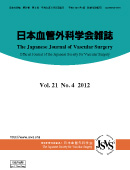Volume 21, Issue 4
Displaying 1-14 of 14 articles from this issue
- |<
- <
- 1
- >
- >|
-
2012Volume 21Issue 4 Pages 21_04_I-21_04_II
Published: June 25, 2012
Released on J-STAGE: June 26, 2012
Download PDF (284K)
Original Articles
-
2012Volume 21Issue 4 Pages 583-588
Published: June 25, 2012
Released on J-STAGE: June 26, 2012
Download PDF (592K) -
2012Volume 21Issue 4 Pages 589-593
Published: June 25, 2012
Released on J-STAGE: June 26, 2012
Download PDF (341K) -
2012Volume 21Issue 4 Pages 595-598
Published: June 25, 2012
Released on J-STAGE: June 26, 2012
Download PDF (310K)
Case Reports
-
2012Volume 21Issue 4 Pages 599-602
Published: June 25, 2012
Released on J-STAGE: June 26, 2012
Download PDF (803K) -
2012Volume 21Issue 4 Pages 603-606
Published: June 25, 2012
Released on J-STAGE: June 26, 2012
Download PDF (701K) -
2012Volume 21Issue 4 Pages 607-610
Published: June 25, 2012
Released on J-STAGE: June 26, 2012
Download PDF (885K) -
2012Volume 21Issue 4 Pages 611-614
Published: June 25, 2012
Released on J-STAGE: June 26, 2012
Download PDF (929K) -
2012Volume 21Issue 4 Pages 615-618
Published: June 25, 2012
Released on J-STAGE: June 26, 2012
Download PDF (603K) -
2012Volume 21Issue 4 Pages 619-622
Published: June 25, 2012
Released on J-STAGE: June 26, 2012
Download PDF (1403K) -
2012Volume 21Issue 4 Pages 623-625
Published: June 25, 2012
Released on J-STAGE: June 26, 2012
Download PDF (607K) -
2012Volume 21Issue 4 Pages 627-631
Published: June 25, 2012
Released on J-STAGE: June 26, 2012
Download PDF (977K) -
2012Volume 21Issue 4 Pages 633-635
Published: June 25, 2012
Released on J-STAGE: June 26, 2012
Download PDF (802K) -
2012Volume 21Issue 4 Pages 637-640
Published: June 25, 2012
Released on J-STAGE: June 26, 2012
Download PDF (829K)
- |<
- <
- 1
- >
- >|
